Geotechnical Data-Driven Mapping for Resilient Infrastructure: An Augmented Spatial Interpolation Framework
Abstract
1. Introduction
2. Geospatial Interpolation Techniques
2.1. Classical Inverse Distance Weighting (IDW)
2.2. Augmented IDW
2.3. Ordinary Kriging
2.4. Performance Evaluation of Interpolation Algorithms
3. Study Region and Research Methodology
3.1. Study Region
3.2. Geotechnical and Environmental Attributes
3.3. Soil and Subsurface Properties
3.4. Geotechnical Database
3.5. Research Methodology
3.5.1. Data Structuring and Input Preparation
3.5.2. Implementation of Spatial Interpolation Algorithms
3.5.3. Model Calibration and Validation Protocol
3.5.4. Geospatial Processing and Visualization
3.5.5. Integration with Foundation Design Guidelines
4. Results and Discussion
4.1. Statistical Analysis of the Database
4.1.1. Depth-Dependent Behavior and Variability
4.1.2. Distribution and Range Analysis
4.2. GDMs Based on SPT-N
4.3. GDMs Based on Soil Type
4.4. GDMs Based on PI
4.5. Model Validation and Comparison: A Discussion
4.6. Foundation Design Guideline Mapping
4.6.1. Load Intensity (LI)
4.6.2. Safe Bearing Capacity (SBC)
4.6.3. Optimal Depth (OD)
5. Conclusions
- Augmented IDW outperforms classical IDW and Kriging in preserving the local heterogeneity and gradient continuity across all depths (1.5 m, 4.5 m, and 7.5 m). Constraining the smooth monotonic behavior while retaining the important localized anomalies proves essential for subsurface interpretation that is credible.
- Despite its theoretical validity, Kriging’s performance was undermined by its semivariogram sensitivity and stationarity assumptions. This resulted in overgeneralization, particularly in regions with soils that are soft (SPT-N < 5 and Vs < 139 m/s), and these play important roles in seismic design and settlement estimation.
- Classical IDW produced interpolation artifacts and radial biasing effects due to its inverse distance exponent function. It could not model the realistic geotechnical property transition and thus is limited in its usage in stratified or heterogeneous soil settings.
- Descriptive and inferential statistics, like skewness, kurtosis, and robust measures of variation, revealed pronounced vertical and lateral variability in geotechnical properties. These findings highlight the benefit of data-informed zoning in vertically and laterally heterogeneous depositional settings.
- Quantitative validation with the RMSE, MAE, NSE, and PC consistently ranked augmented IDW highest across all key performance indices. Compared to classical IDW and Kriging, the augmented IDW algorithm achieved up to a 44% average reduction in the RMSE and MAE, along with an approximately 30% improvement in NSE and PC. Moreover, scatterplots indicated better predictive consistency with field observation values from the boreholes, through cross-validation, demonstrating tightly packed clusters of predicted values along the trend line.
- The derived spatial maps of the load intensity (LI), safe bearing capacity (SBC), and optimum depth (OD) offer a translational connection between geostatistical modeling and the design of civil infrastructure. The thematic maps support early-stage planning, reduce excavation depth uncertainty, and offer cost-saving foundation planning.
- Augmented IDW offers computational scalability and rapid prototyping for geotechnical evaluations over large scales. The method can be extended to other regions facing geologic sparsity or variability.
Author Contributions
Funding
Data Availability Statement
Acknowledgments
Conflicts of Interest
References
- Sadeghi, H.; Kiani, M.; Sadeghi, M.; Jafarzadeh, F. Geotechnical characterization and collapsibility of a natural dispersive loess. Eng. Geol. 2019, 250, 89–100. [Google Scholar] [CrossRef]
- Bicocchi, G.; Tofani, V.; D’aMbrosio, M.; Tacconi-Stefanelli, C.; Vannocci, P.; Casagli, N.; Lavorini, G.; Trevisani, M.; Catani, F. Geotechnical and hydrological characterization of hillslope deposits for regional landslide prediction modeling. Bull. Eng. Geol. Environ. 2019, 78, 4875–4891. [Google Scholar] [CrossRef]
- Huang, G.; Wu, Y.; Cheng, L.; Zhou, D.; Wang, X.; Ding, M.; Wang, P.; Wang, Y. Spatial heterogeneity of soil moisture caused by drainage and its effects on cadmium variation in rice grain within individual fields. Sci. Total Environ. 2024, 946, 174500. [Google Scholar] [CrossRef]
- Domènech, G.; Alvioli, M.; Corominas, J. Preparing first-time slope failures hazard maps: From pixel-based to slope unit-based. Landslides 2020, 17, 249–265. [Google Scholar] [CrossRef]
- Bagheri-Gavkosh, M.; Hosseini, S.M.; Ataie-Ashtiani, B.; Sohani, Y.; Ebrahimian, H.; Morovat, F.; Ashrafi, S. Land subsidence: A global challenge. Sci. Total Environ. 2021, 778, 146193. [Google Scholar] [CrossRef]
- Alhaji, M.M.; Alhassan, M.; Adejumo, T.W.; Abdulkadir, H. Road pavement collapse from overloaded trucks due to traffic diversion: A case study of Minna-Kateregi-Bida Road, Nigeria. Eng. Fail. Anal. 2022, 131, 105829. [Google Scholar] [CrossRef]
- Harman, B.I.; Koseoglu, H.; Yigit, C.O. Performance evaluation of IDW, Kriging and multiquadric interpolation methods in producing noise mapping: A case study at the city of Isparta, Turkey. Appl. Acoust. 2016, 112, 147–157. [Google Scholar] [CrossRef]
- Khan, M.; Almazah, M.M.; EIlahi, A.; Niaz, R.; Al-Rezami, A.Y.; Zaman, B. Spatial interpolation of water quality index based on Ordinary kriging and Universal kriging. Geomat. Nat. Hazards Risk 2023, 14, 2190853. [Google Scholar] [CrossRef]
- Ijaz, Z.; Zhao, C.; Ijaz, N.; Rehman, Z.U.; Ijaz, A. Development and optimization of geotechnical soil maps using various geostatistical and spatial interpolation techniques: A comprehensive study. Bull. Eng. Geol. Environ. 2023, 82, 215. [Google Scholar] [CrossRef]
- Sheng, J.; Yu, P.; Zhang, H.; Wang, Z. Spatial variability of soil Cd content based on IDW and RBF in Fujiang River, Mianyang, China. J. Soils Sediments 2021, 21, 419–429. [Google Scholar] [CrossRef]
- Zhang, L.; Lu, Z.; Wang, P. Efficient structural reliability analysis method based on advanced Kriging model. Appl. Math. Model. 2015, 39, 781–793. [Google Scholar] [CrossRef]
- Nikiforova, A.A.; Fleis, M.E.; Nyrtsov, M.V.; Kazantsev, N.N.; Kim, K.V.; Belyonova, N.K.; Kim, J.K. Problems of modern soil mapping and ways to solve them. Catena 2020, 195, 104885. [Google Scholar] [CrossRef]
- Wadoux, A.M.C.; Minasny, B.; McBratney, A.B. Machine learning for digital soil mapping: Applications, challenges and suggested solutions. Earth-Sci. Rev. 2020, 210, 103359. [Google Scholar] [CrossRef]
- Hassan, W.; Alshameri, B.; Nawaz, M.N.; Ijaz, Z.; Qasim, M. Geospatial and statistical interpolation of geotechnical data for modeling zonation maps of Islamabad, Pakistan. Environ. Earth Sci. 2022, 81, 547. [Google Scholar] [CrossRef]
- Civelekler, E.; Pekkan, E. The application of GIS in visualization of geotechnical data (SPT-Soil Properties): A case study in Eskisehir-Tepebaşı, Turkey. Int. J. Eng. Geosci. 2022, 7, 302–313. [Google Scholar] [CrossRef]
- Griffiths, J.S.; Fookes, P.G.; Hardingham, A.D.; Barsby, R.D. Geotechnical soils mapping for construction purposes in Central Saudi Arabia. In Engineering Characteristics of Arid Soils; CRC Press: Boca Raton, FL, USA, 2020; pp. 69–85. [Google Scholar]
- Walker, R.T. Geography, Von Thünen, and Tobler’s first law: Tracing the evolution of a concept. Geogr. Rev. 2022, 112, 591–607. [Google Scholar] [CrossRef]
- Zhu, A.X.; Turner, M. How is the third law of geography different? Ann. GIS 2022, 28, 57–67. [Google Scholar] [CrossRef]
- Ijaz, Z.; Zhao, C.; Ijaz, N.; Rehman, Z.U.; Ijaz, A. Statistical evaluation of multiple interpolation techniques for spatial mapping of highly variable geotechnical facets of soil in natural deposition. Earth Sci. Inform. 2023, 16, 105–129. [Google Scholar] [CrossRef]
- Ahmad, D.; Afzal, M. Flood hazards and livelihood vulnerability of flood-prone farm-dependent Bait households in Punjab, Pakistan. Environ. Sci. Pollut. Res. 2022, 29, 11553–11573. [Google Scholar] [CrossRef]
- Al-Mamoori, S.K.; Al-Maliki, L.A.; Al-Sulttani, A.H.; El-Tawil, K.; Al-Ansari, N. Statistical analysis of the best GIS interpolation method for bearing capacity estimation in An-Najaf City, Iraq. Environ. Earth Sci. 2021, 80, 683. [Google Scholar] [CrossRef]
- Ijaz, N.; Ijaz, Z.; Zhou, N.; Rehman, Z.U.; Ijaz, H.; Ijaz, A.; Hamza, M. Optimizing subsurface geotechnical data integration for sustainable building infrastructure. Buildings 2025, 15, 140. [Google Scholar] [CrossRef]
- Maleika, W. Inverse distance weighting method optimization in the process of digital terrain model creation based on data collected from a multibeam echosounder. Appl. Geomat. 2020, 12, 397–407. [Google Scholar] [CrossRef]
- Gia Pham, T.; Kappas, M.; Van Huynh, C.; Hoang Khanh Nguyen, L. Application of ordinary kriging and regression kriging method for soil properties mapping in hilly region of central Vietnam. ISPRS Int. J. Geo-Inf. 2019, 8, 147. [Google Scholar] [CrossRef]
- Chai, T. Root Mean Square. In Encyclopedia of Mathematical Geosciences; Springer International Publishing: Cham, Switzerland, 2022; pp. 1–3. [Google Scholar]
- Melsen, L.A.; Puy, A.; Torfs, P.J.J.F.; Saltelli, A. The rise of the Nash-Sutcliffe efficiency in hydrology. Hydrol. Sci. J. 2025, 70, 1248–1259. [Google Scholar] [CrossRef]
- Afzal, M.; Liu, T.; Butt, A.Q.; Nadeem, A.A.; Ali, S.; Pan, X. Geospatial assessment of managed aquifer recharge potential sites in Punjab, Pakistan. Remote Sens. 2023, 15, 3988. [Google Scholar] [CrossRef]
- Latif, R.M.A.; He, J. Flood Susceptibility Mapping in Punjab, Pakistan: A Hybrid Approach Integrating Remote Sensing and Analytical Hierarchy Process. Atmosphere 2024, 16, 22. [Google Scholar] [CrossRef]
- Elahi, E.; Khalid, Z.; Tauni, M.Z.; Zhang, H.; Lirong, X. Extreme weather events risk to crop-production and the adaptation of innovative management strategies to mitigate the risk: A retrospective survey of rural Punjab, Pakistan. Technovation 2022, 117, 102255. [Google Scholar] [CrossRef]
- Paras, I.; Mohey-Ud-Din, G.; Fareed, F. Infrastructure development in punjab, pakistan: From assessment to spatiotemporal analysis at district level. J. Quant. Methods 2018, 2, 75–103. [Google Scholar] [CrossRef]
- Simard, M.; Denbina, M.; Marshak, C.; Neumann, M. A global evaluation of radar-derived digital elevation models: SRTM, NASADEM, and GLO-30. J. Geophys. Res. Biogeosci. 2024, 129, e2023JG007672. [Google Scholar] [CrossRef]
- Panagos, P.; Borrelli, P.; Poesen, J.; Ballabio, C.; Lugato, E.; Meusburger, K.; Montanarella, L.; Alewell, C. The new assessment of soil loss by water erosion in Europe. Environ. Sci. Policy 2015, 54, 438–447. [Google Scholar] [CrossRef]
- Hussain, S.; Karuppannan, S. Land use/land cover changes and their impact on land surface temperature using remote sensing technique in district Khanewal, Punjab Pakistan. Geol. Ecol. Landsc. 2023, 7, 46–58. [Google Scholar] [CrossRef]
- Hengl, T. Sand Content in % (kg/kg) at 6 Standard Depths (0, 10, 30, 60, 100 and 200 cm) at 250 m Resolution (Version v02) [Data Set]. Zenodo. 2018. Available online: https://zenodo.org/records/2525662 (accessed on 25 July 2025).
- Wang, Z.Z.; Jiang, S.H. Characterizing geotechnical site investigation data: A comparative study using a novel distribution model. Acta Geotech. 2023, 18, 1821–1839. [Google Scholar] [CrossRef]
- Hatta, K.A.; Syed Osman, S.B.A. Correlation of electrical resistivity and SPT-N value from standard penetration test (SPT) of sandy soil. Appl. Mech. Mater. 2015, 785, 702–706. [Google Scholar] [CrossRef]
- Ghazi, A.; Moghadas, N.H.; Sadeghi, H.; Ghafoori, M.; Lashkaripur, G.R. Empirical relationships of shear wave velocity, SPT-N value and vertical effective stress for different soils in Mashhad, Iran. Ann. Geophys. 2015, 58, S0325. [Google Scholar] [CrossRef]


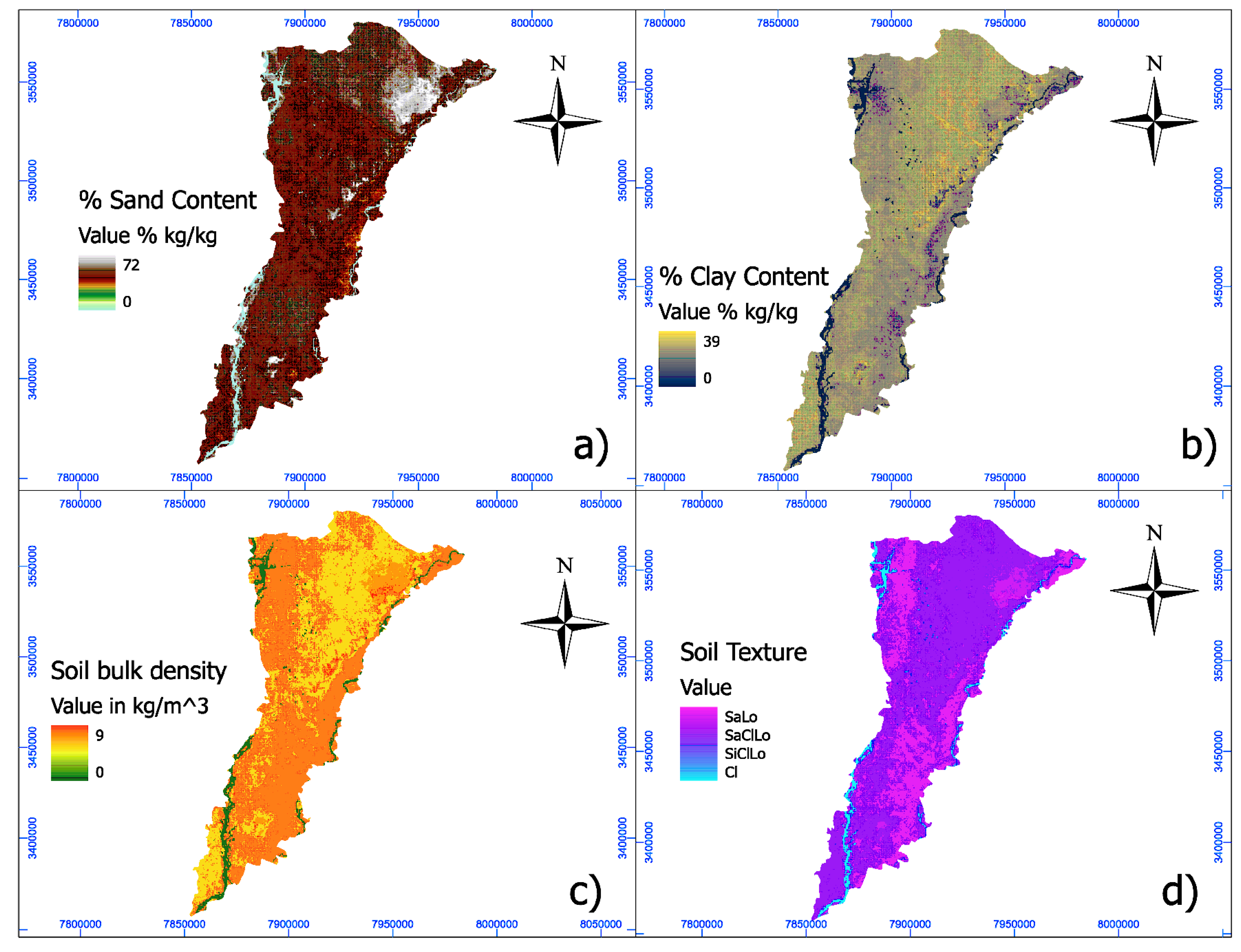

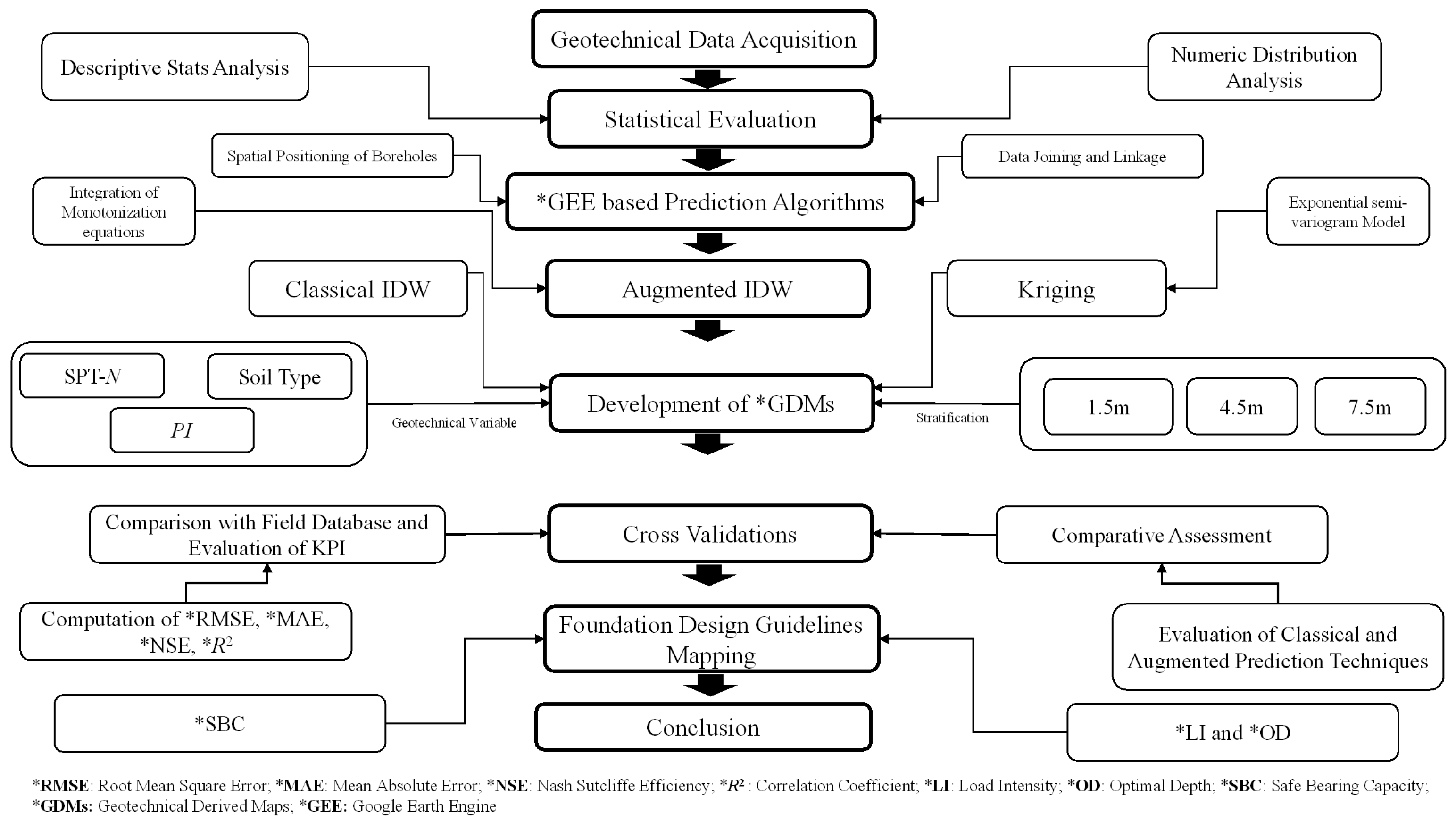


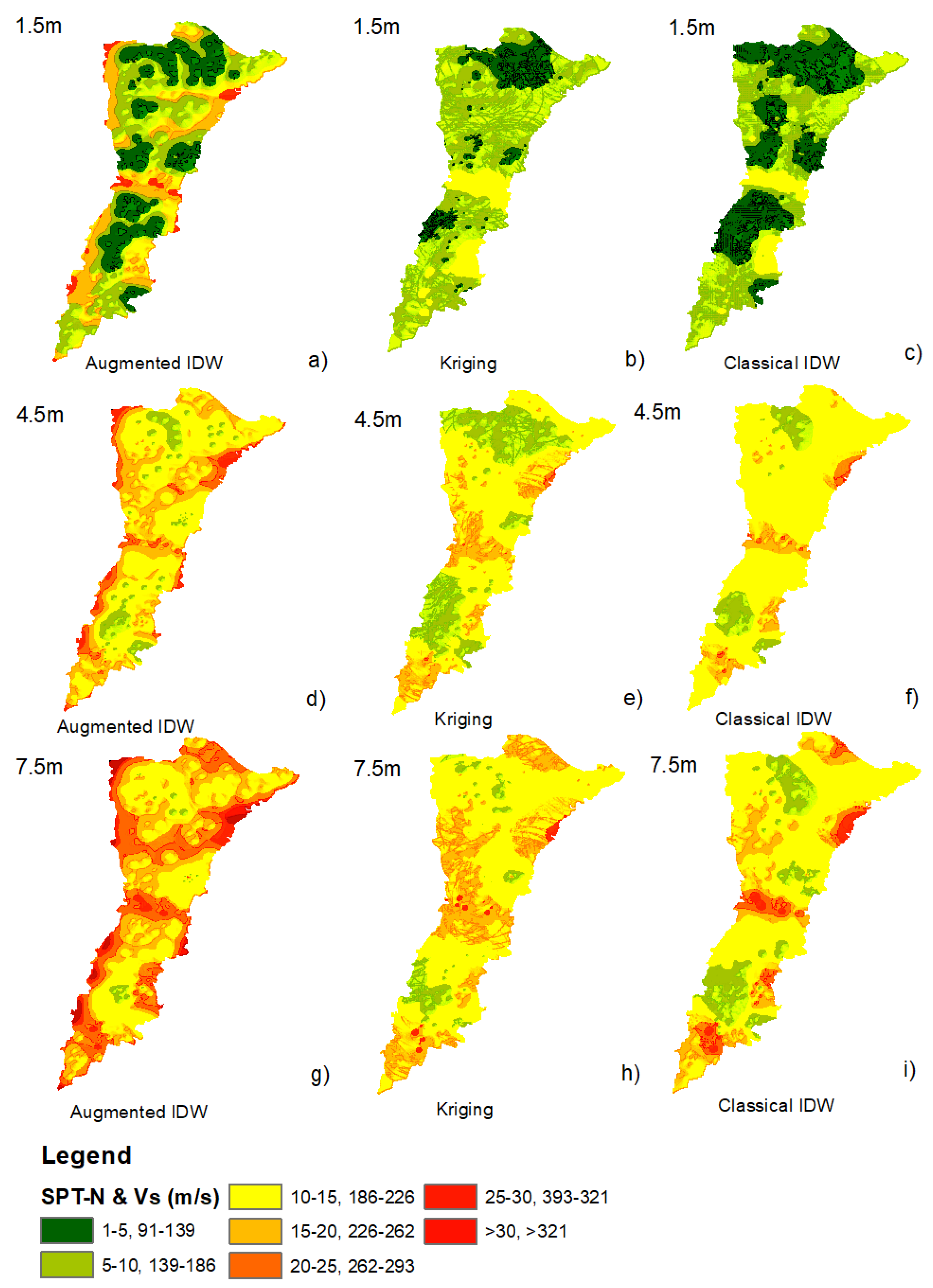
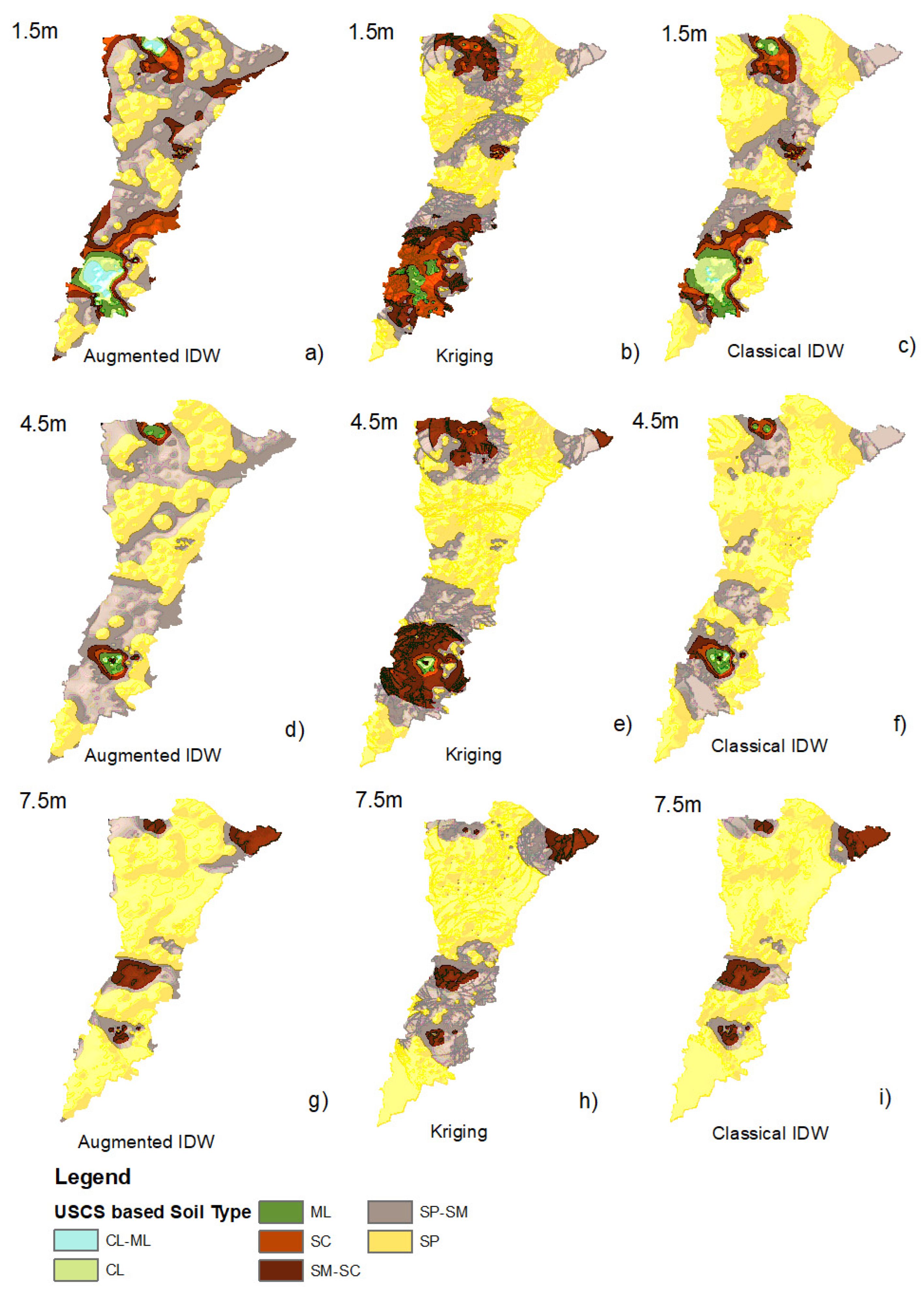
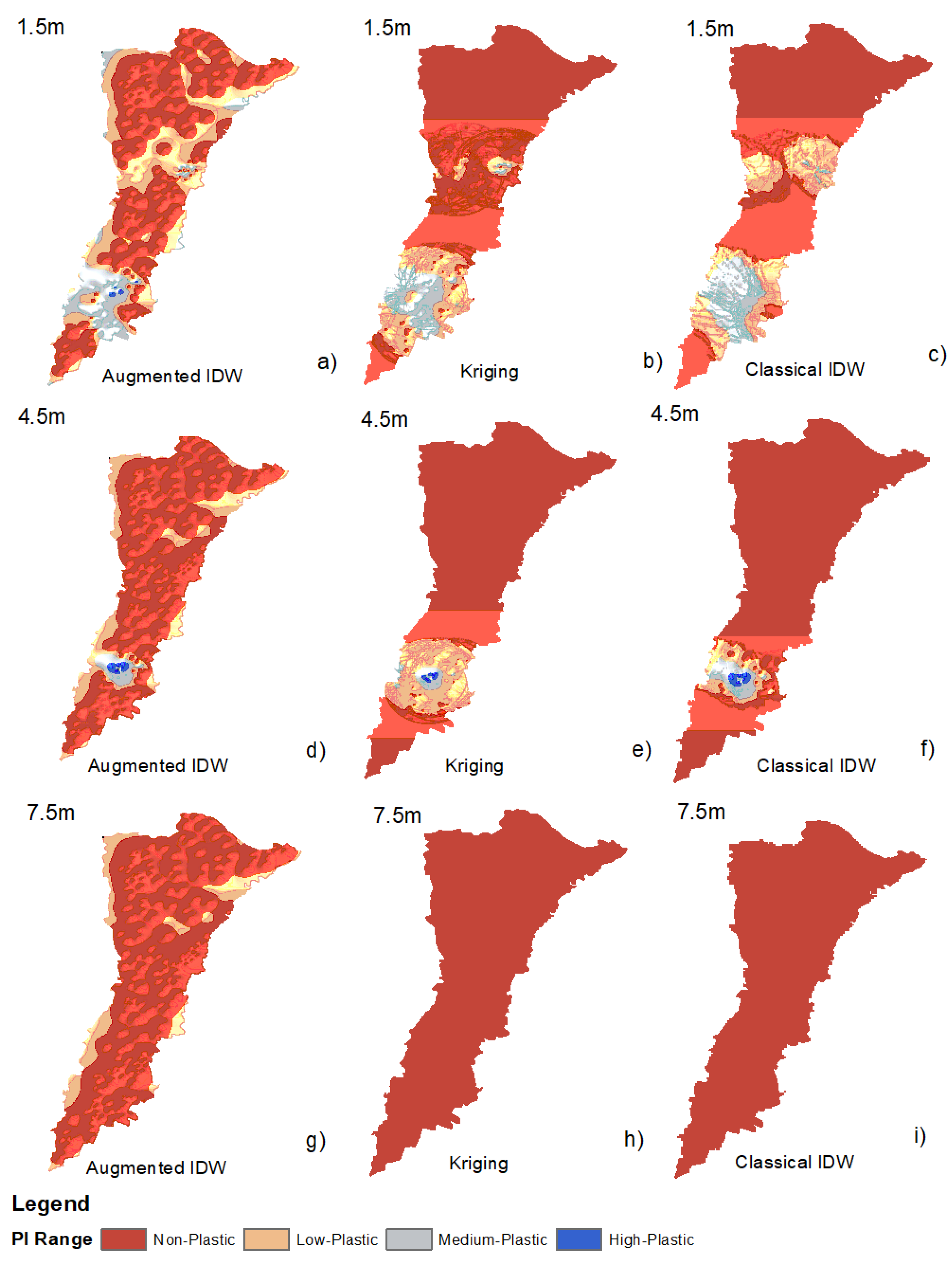
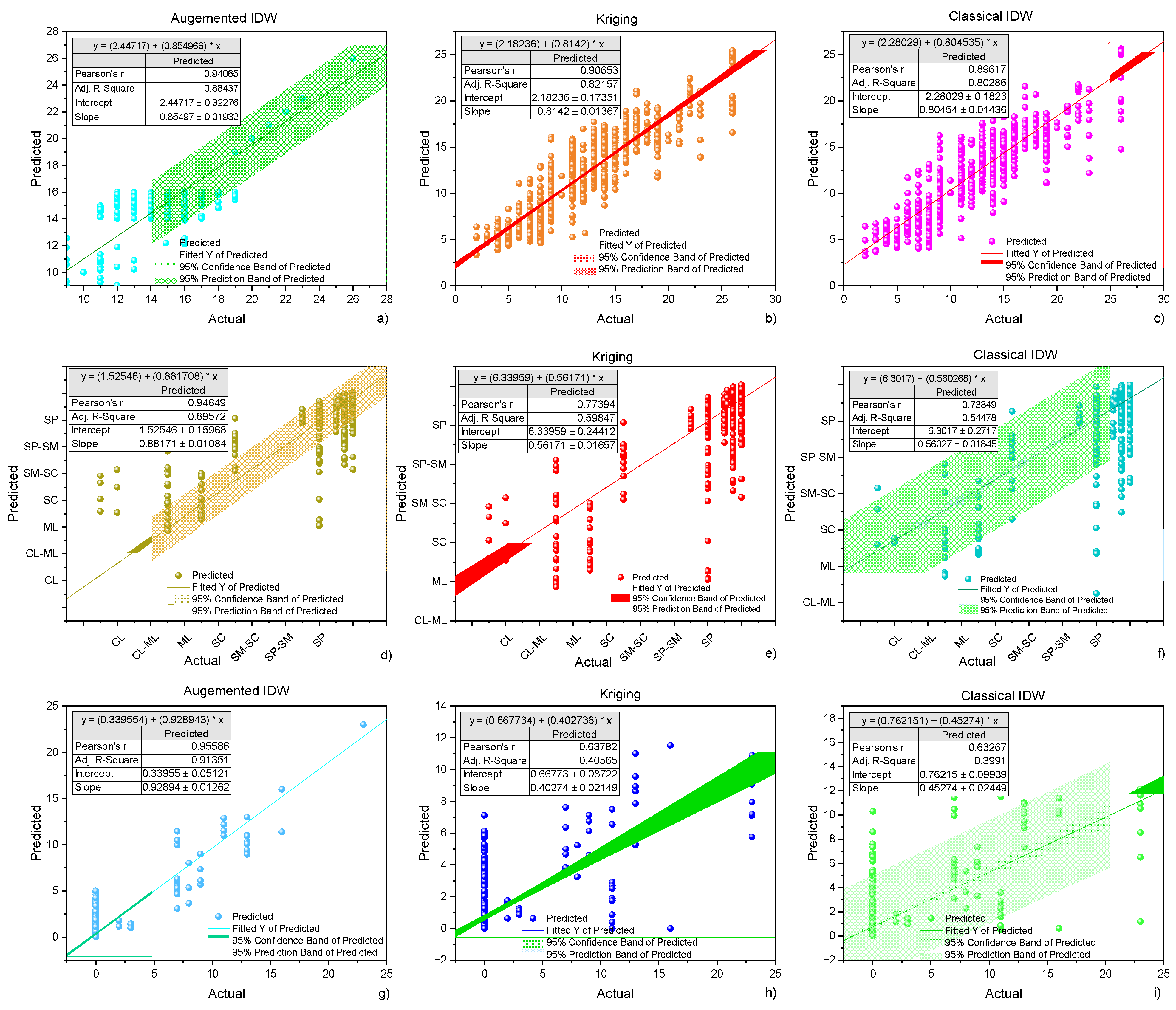

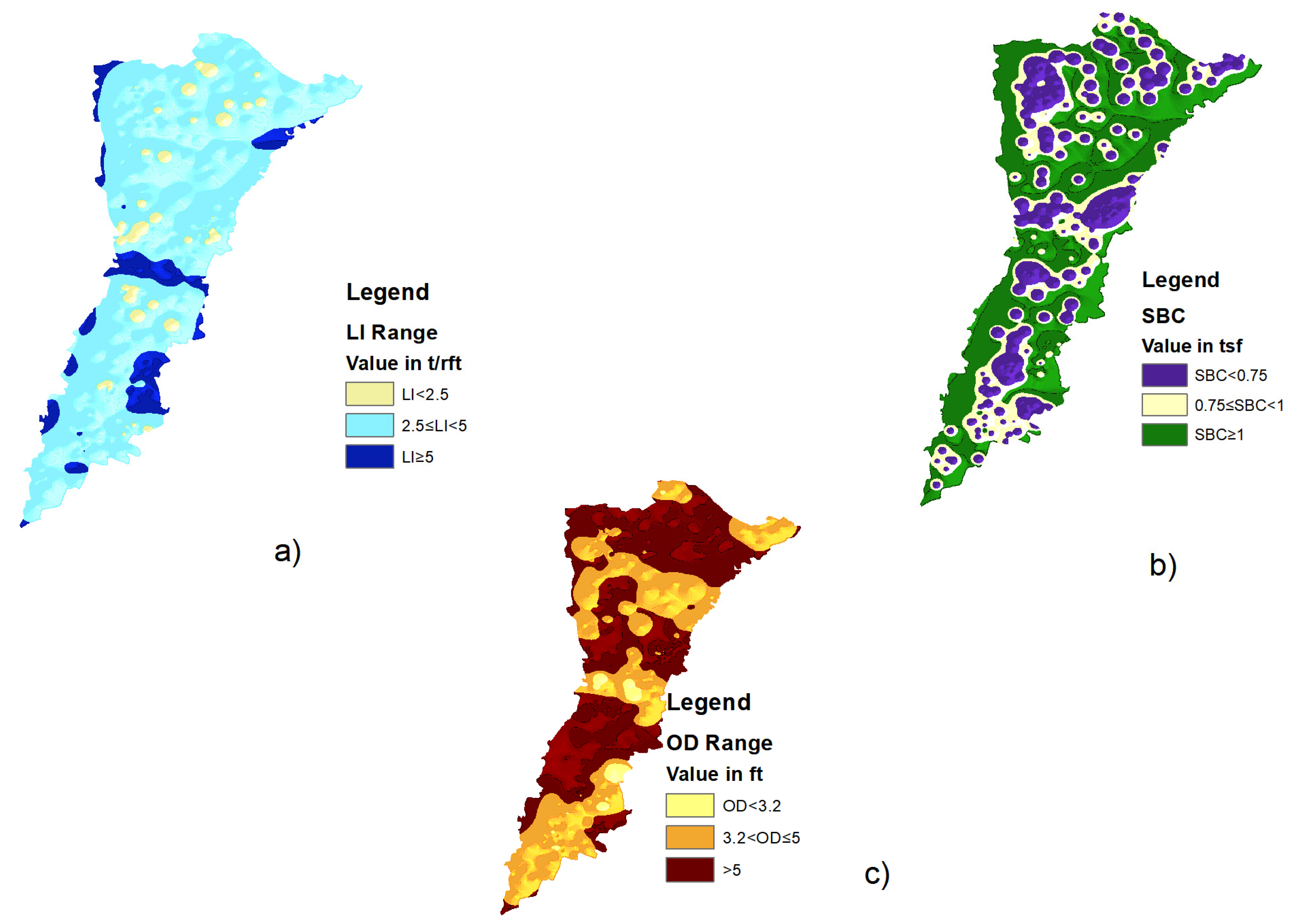
| Variable | Depth | Mean | SD | SE * of Mean | Skewness | Kurtosis | MAD * | IQR * | RCV * |
|---|---|---|---|---|---|---|---|---|---|
| SPT-N | 1.5 | 6.4 | 2.4 | 0.1 | 1.1 | 1.6 | 1.8 | 3.0 | 0.2 |
| 4.5 | 12.1 | 3.5 | 0.2 | 0.8 | 0.7 | 2.7 | 5.0 | 0.2 | |
| 7.5 | 16.3 | 3.9 | 0.2 | 0.9 | 0.4 | 3.0 | 5.0 | 0.3 | |
| Soil Type | 1.5 | 13.4 | 3.5 | 0.2 | −1.4 | 0.5 | 2.7 | 1.5 | 0.0 |
| 4.5 | 14.5 | 2.7 | 0.2 | −3.8 | 14.9 | 1.4 | 1.5 | 0.0 | |
| 7.5 | 14.8 | 2.6 | 0.2 | −3.8 | 14.6 | 1.4 | 2.0 | 0.0 | |
| PI | 1.5 | 1.5 | 3.7 | 0.2 | 2.4 | 4.8 | 2.5 | 0.0 | - |
| 4.5 | 0.7 | 3.7 | 0.2 | 5.4 | 28.7 | 1.4 | 0.0 | - | |
| 7.5 | 0.0 | 0.0 | 0.0 | - | - | 0.0 | 0.0 | - |
Disclaimer/Publisher’s Note: The statements, opinions and data contained in all publications are solely those of the individual author(s) and contributor(s) and not of MDPI and/or the editor(s). MDPI and/or the editor(s) disclaim responsibility for any injury to people or property resulting from any ideas, methods, instructions or products referred to in the content. |
© 2025 by the authors. Licensee MDPI, Basel, Switzerland. This article is an open access article distributed under the terms and conditions of the Creative Commons Attribution (CC BY) license (https://creativecommons.org/licenses/by/4.0/).
Share and Cite
Ijaz, N.; Ijaz, Z.; Zhou, N.; ur Rehman, Z.; Abbas Jaffar, S.T.; Ijaz, H.; Ijaz, A. Geotechnical Data-Driven Mapping for Resilient Infrastructure: An Augmented Spatial Interpolation Framework. Buildings 2025, 15, 3211. https://doi.org/10.3390/buildings15173211
Ijaz N, Ijaz Z, Zhou N, ur Rehman Z, Abbas Jaffar ST, Ijaz H, Ijaz A. Geotechnical Data-Driven Mapping for Resilient Infrastructure: An Augmented Spatial Interpolation Framework. Buildings. 2025; 15(17):3211. https://doi.org/10.3390/buildings15173211
Chicago/Turabian StyleIjaz, Nauman, Zain Ijaz, Nianqing Zhou, Zia ur Rehman, Syed Taseer Abbas Jaffar, Hamdoon Ijaz, and Aashan Ijaz. 2025. "Geotechnical Data-Driven Mapping for Resilient Infrastructure: An Augmented Spatial Interpolation Framework" Buildings 15, no. 17: 3211. https://doi.org/10.3390/buildings15173211
APA StyleIjaz, N., Ijaz, Z., Zhou, N., ur Rehman, Z., Abbas Jaffar, S. T., Ijaz, H., & Ijaz, A. (2025). Geotechnical Data-Driven Mapping for Resilient Infrastructure: An Augmented Spatial Interpolation Framework. Buildings, 15(17), 3211. https://doi.org/10.3390/buildings15173211








